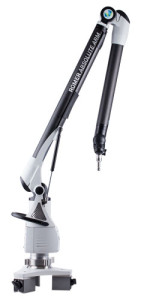Romer Absolute Arm User Manual Pdf
Posted : admin On 28.05.2020- Romer Absolute Arm Manual
- Romer Absolute Arm Troubleshooting
- Romer Arm Operating Manual
- Romer Arm User Manual
- Romer Infinite 2.0 User Manual
ROMER Absolute Arm. 1 The Point Repeatability Test is the reference test to determine measurement arm repeatability with ball probe. The cone is in front of the machine. Points are measured from multiple approach directions. We provide full calibrations on Romer portable arms and can inspect and issue a certificate for Faro arms. It is important to understand that a portable arm needs more scrutiny than a coordinate measuring machine. A coordinate measuring machine stays in one spot while a portable arm, by the nature portable, is moved throughout a factory.
Ask the question you have about the Casio Edifice ECW-M300EDB-1AER here simply to other product owners. Provide a clear and comprehensive description of the problem and your question. The better your problem and question is described, the easier it is for other Casio Edifice ECW-M300EDB-1AER owners to provide you with a good answer. A good user manual The rules should oblige the seller to give the purchaser an operating instrucion of Casio ECW-M300EDB-1AER, along with an item. The lack of an instruction or false information given to customer shall constitute grounds to apply for a complaint because. Casio ecw-m300edb-1aer manual.
A ROMER Arm is a term for a portable coordinate measuring machine ROMER, a company Acquired by the Hexagon AB group, and part of the Manufacturing Intelligence division, designed the ROMER arm in the 1980s to solve the problem of how to measure large objects such as airplanes and car bodies without moving them to a dedicated measuring laboratory. A coordinate measuring machine precisely measures an object in a 3D coordinate system, often in comparison to a computer aided design (CAD) model. A portable coordinate measuring machine is usually a manual measuring device, which indicates that it requires a person to operate it.
Romer Absolute Arm Manual
The arm operates in 3D space with 6 or 7 joints, comprising 6 degrees of freedom (6DoF), which means that the arm can move in three-dimensional space forward/backward, up/down, left/right combined with rotation about three perpendicular axes (roll, yaw, pitch). The movement along each of the three axes is independent of each other and independent of the rotation about any of these axes, comprising the 6 degrees of freedom. The physical arrangement of the arm is much like a human arm, with a wrist, forearm, elbow, and so on.
ROMER arms are used for industrial measuring tasks where the part to be measured is too large or inconvenient to be moved. The measuring arm is brought to the part, which is possible because of the light weight of the system (less than 20 pounds).
History[edit]

The original design for the ROMER arm is based on US patent 3,944,798, filed in 1974 by Homer Eaton, one of ROMER's founders, while working at Eaton Leonard. At that time, the measuring arm was intended solely for the measurement of bent tube geometry. Later, Eaton teamed up with colleague Romain Granger to create ROMER SARL (France) to create portable measuring arms for general purpose industrial measuring applications.
The word ROMER comes from a combination of the two founders' names: Romain Granger and Homer Eaton.
Romer Absolute Arm Troubleshooting
The ROMER companies today are part of Hexagon Manufacturing Intelligence.
Romer Arm Operating Manual
In August 2018 Hexagon Manufacturing Intelligence renamed the product to the Absolute Arm consigning the name ROMER to the history books.
References[edit]
Romer Arm User Manual
- Patent 3,944,798 Patent Text
- History of the Articulated Arm Quality Magazine Article
- Absolute Arm Website